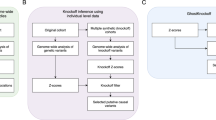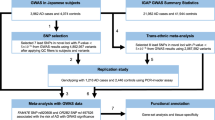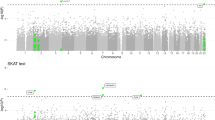Abstract
With the advent of technologies that allow simultaneous genotyping of thousands of single-nucleotide polymorphisms (SNPs) across the genome, the genetic contributions to complex diseases can be explored at an unprecedented detail. This study is among the first to apply the genome-wide association study (GWAS) approach to Alzheimer disease (AD). We present our GWAS results from the German population for genes included in the ‘Top Results’ list on the AlzGene database website. In addition to the apolipoprotein E locus, we identified nominally significant association signals in six of the ten genes investigated, albeit predominantly for SNPs other than those already published as being disease associated. Further, all of the four AD genes previously identified through GWAS also showed nominally significant association signals in our data. The results of our comparative study reinforce the necessity for replication and validation, not only of GWAS but also of candidate gene case–control studies, in different populations. Furthermore, cross-platform comparison of genotyping results can also identify new association signals. Finally, our data confirm that GWAS, regardless of the platform, are valuable for the identification of genetic variants associated with AD.
This is a preview of subscription content, access via your institution
Access options
Subscribe to this journal
Receive 12 print issues and online access
$259.00 per year
only $21.58 per issue
Buy this article
- Purchase on Springer Link
- Instant access to full article PDF
Prices may be subject to local taxes which are calculated during checkout




Similar content being viewed by others
References
Goate A, Chartier-Harlin MC, Mullan M, Brown J, Crawford F, Fidani L et al. Segregation of a missense mutation in the amyloid precursor protein gene with familial Alzheimer's disease. Nature 1991; 349: 704–706.
Levy-Lahad E, Lahad A, Wijsman EM, Bird TD, Schellenberg GD . Apolipoprotein E genotypes and age of onset in early-onset familial Alzheimer's disease. Ann Neurol 1995; 38: 678–680.
Sherrington R, Rogaev EI, Liang Y, Rogaeva EA, Levesque G, Ikeda M et al. Cloning of a gene bearing missense mutations in early-onset familial Alzheimer's disease. Nature 1995; 375: 754–760.
Saunders AM . Gene identification in Alzheimer's disease. Pharmacogenomics 2001; 2: 239–249.
Sando SB, Melquist S, Cannon A, Hutton ML, Sletvold O, Saltvedt I et al. APOE epsilon4 lowers age at onset and is a high risk factor for Alzheimer's disease; a case control study from central Norway. BMC Neurol 2008; 8: 9.
Corder EH, Saunders AM, Strittmatter WJ, Schmechel DE, Gaskell PC, Small GW et al. Gene dose of apolipoprotein E type 4 allele and the risk of Alzheimer's disease in late onset families. Science 1993; 261: 921–923.
Corder EH, Saunders AM, Risch NJ, Strittmatter WJ, Schmechel DE, Gaskell Jr PC et al. Protective effect of apolipoprotein E type 2 allele for late onset Alzheimer disease. Nat Genet 1994; 7: 180–184.
Strittmatter WJ, Weisgraber KH, Huang DY, Dong LM, Salvesen GS, Pericak-Vance M et al. Binding of human apolipoprotein E to synthetic amyloid beta peptide: isoform-specific effects and implications for late-onset Alzheimer disease. Proc Natl Acad Sci USA 1993; 90: 8098–8102.
McDowell I . Alzheimer's disease: insights from epidemiology. Aging (Milano) 2001; 13: 143–162.
Daw EW, Payami H, Nemens EJ, Nochlin D, Bird TD, Schellenberg GD et al. The number of trait loci in late-onset Alzheimer disease. Am J Hum Genet 2000; 66: 196–204.
Bertram L, Blacker D, Mullin K, Keeney D, Jones J, Basu S et al. Evidence for genetic linkage of Alzheimer's disease to chromosome 10q. Science 2000; 290: 2302–2303.
Myers A, Holmans P, Marshall H, Kwon J, Meyer D, Ramic D et al. Susceptibility locus for Alzheimer's disease on chromosome 10. Science 2000; 290: 2304–2305.
Myers A, Wavrant De-Vrieze F, Holmans P, Hamshere M, Crook R, Compton D et al. Full genome screen for Alzheimer disease: stage II analysis. Am J Med Genet 2002; 114: 235–244.
Li YJ, Scott WK, Hedges DJ, Zhang F, Gaskell PC, Nance MA et al. Age at onset in two common neurodegenerative diseases is genetically controlled. Am J Hum Genet 2002; 70: 985–993.
Ertekin-Taner N, Graff-Radford N, Younkin LH, Eckman C, Baker M, Adamson J et al. Linkage of plasma Abeta42 to a quantitative locus on chromosome 10 in late-onset Alzheimer's disease pedigrees. Science 2000; 290: 2303–2304.
Farrer LA, Cupples LA, Haines JL, Hyman B, Kukull WA, Mayeux R et al. Effects of age, sex, and ethnicity on the association between apolipoprotein E genotype and Alzheimer disease. A meta-analysis. APOE and Alzheimer Disease Meta Analysis Consortium. JAMA 1997; 278: 1349–1356.
Bertram L, McQueen MB, Mullin K, Blacker D, Tanzi RE . Systematic meta-analyses of Alzheimer disease genetic association studies: the AlzGene database. Nat Genet 2007; 39: 17–23.
Martin ER, Lai EH, Gilbert JR, Rogala AR, Afshari AJ, Riley J et al. SNPing away at complex diseases: analysis of single-nucleotide polymorphisms around APOE in Alzheimer disease. Am J Hum Genet 2000; 67: 383–394.
Yu CE, Seltman H, Peskind ER, Galloway N, Zhou PX, Rosenthal E et al. Comprehensive analysis of APOE and selected proximate markers for late-onset Alzheimer's disease: patterns of linkage disequilibrium and disease/marker association. Genomics 2007; 89: 655–665.
Li H, Wetten S, Li L, St Jean PL, Upmanyu R, Surh L et al. Candidate single-nucleotide polymorphisms from a genomewide association study of Alzheimer disease. Arch Neurol 2008; 65: 45–53.
Reiman EM, Webster JA, Myers AJ, Hardy J, Dunckley T, Zismann VL et al. GAB2 alleles modify Alzheimer's risk in APOE epsilon4 carriers. Neuron 2007; 54: 713–720.
Grupe A, Abraham R, Li Y, Rowland C, Hollingworth P, Morgan A et al. Evidence for novel susceptibility genes for late-onset Alzheimer's disease from a genome-wide association study of putative functional variants. Hum Mol Genet 2007; 16: 865–873.
McKhann G, Drachman D, Folstein M, Katzman R, Price D, Stadlan EM . Clinical diagnosis of Alzheimer's disease: report of the NINCDS-ADRDA Work Group under the auspices of Department of Health and Human Services Task Force on Alzheimer's Disease. Neurology 1984; 34: 939–944.
Roth M, Tym E, Mountjoy CQ, Huppert FA, Hendrie H, Verma S et al. CAMDEX. A standardised instrument for the diagnosis of mental disorder in the elderly with special reference to the early detection of dementia. Br J Psychiatry 1986; 149: 698–709.
Welsh KA, Butters N, Mohs RC, Beekly D, Edland S, Fillenbaum G et al. The Consortium to Establish a Registry for Alzheimer's Disease (CERAD). Part V. A normative study of the neuropsychological battery. Neurology 1994; 44: 609–614.
Folstein MF, Folstein SE, McHugh PR . Mini-mental state. A practical method for grading the cognitive state of patients for the clinician. J Psychiatr Res 1975; 12: 189–198.
Gunderson KL, Steemers FJ, Lee G, Mendoza LG, Chee MS . A genome-wide scalable SNP genotyping assay using microarray technology. Nat Genet 2005; 37: 549–554.
Steemers FJ, Chang W, Lee G, Barker DL, Shen R, Gunderson KL . Whole-genome genotyping with the single-base extension assay. Nat Methods 2006; 3: 31–33.
International HapMap Consortium. A haplotype map of the human genome. Nature 2005; 437: 1299–1320.
Conrad DF, Andrews TD, Carter NP, Hurles ME, Pritchard JK . A high-resolution survey of deletion polymorphism in the human genome. Nat Genet 2006; 38: 75–81.
Hinds DA, Kloek AP, Jen M, Chen X, Frazer KA . Common deletions and SNPs are in linkage disequilibrium in the human genome. Nat Genet 2006; 38: 82–85.
McCarroll SA, Hadnott TN, Perry GH, Sabeti PC, Zody MC, Barrett JC et al. Common deletion polymorphisms in the human genome. Nat Genet 2006; 38: 86–92.
Gabriel SB, Schaffner SF, Nguyen H, Moore JM, Roy J, Blumenstiel B et al. The structure of haplotype blocks in the human genome. Science 2002; 296: 2225–2229.
Barrett JC, Fry B, Maller J, Daly MJ . Haploview: analysis and visualization of LD and haplotype maps. Bioinformatics 2005; 21: 263–265.
Cook LJ, Ho LW, Taylor AE, Brayne C, Evans JG, Xuereb J et al. Candidate gene association studies of the alpha 4 (CHRNA4) and beta 2 (CHRNB2) neuronal nicotinic acetylcholine receptor subunit genes in Alzheimer's disease. Neurosci Lett 2004; 358: 142–146.
Papassotiropoulos A, Lambert JC, Wavrant-De Vrieze F, Wollmer MA, von der Kammer H, Streffer JR et al. Cholesterol 25-hydroxylase on chromosome 10q is a susceptibility gene for sporadic Alzheimer's disease. Neurodegener Dis 2005; 2: 233–241.
Finckh U, von der Kammer H, Velden J, Michel T, Andresen B, Deng A et al. Genetic association of a cystatin C gene polymorphism with late-onset Alzheimer disease. Arch Neurol 2000; 57: 1579–1583.
Dodel RC, Du Y, Depboylu C, Kurz A, Eastwood B, Farlow M et al. A polymorphism in the cystatin C promoter region is not associated with an increased risk of AD. Neurology 2002; 58: 664.
Cathcart HM, Huang R, Lanham IS, Corder EH, Poduslo SE . Cystatin C as a risk factor for Alzheimer disease. Neurology 2005; 64: 755–757.
Mukherjee O, Kauwe JS, Mayo K, Morris JC, Goate AM . Haplotype-based association analysis of the MAPT locus in late onset Alzheimer's disease. BMC Genet 2007; 8: 3.
Myers AJ, Pittman AM, Zhao AS, Rohrer K, Kaleem M, Marlowe L et al. The MAPT H1c risk haplotype is associated with increased expression of tau and especially of 4 repeat containing transcripts. Neurobiol Dis 2007; 25: 561–570.
Laws SM, Friedrich P, Diehl-Schmid J, Muller J, Eisele T, Bauml J et al. Fine mapping of the MAPT locus using quantitative trait analysis identifies possible causal variants in Alzheimer's disease. Mol Psychiatry 2007; 12: 510–517.
Rogaeva E, Meng Y, Lee JH, Gu Y, Kawarai T, Zou F et al. The neuronal sortilin-related receptor SORL1 is genetically associated with Alzheimer disease. Nat Genet 2007; 39: 168–177.
Lee JH, Cheng R, Schupf N, Manly J, Lantigua R, Stern Y et al. The association between genetic variants in SORL1 and Alzheimer disease in an urban, multiethnic, community-based cohort. Arch Neurol 2007; 64: 501–506.
Myers AJ, Kaleem M, Marlowe L, Pittman AM, Lees AJ, Fung HC et al. The H1c haplotype at the MAPT locus is associated with Alzheimer's disease. Hum Mol Genet 2005; 14: 2399–2404.
Bettens K, Brouwers N, Engelborghs S, De Deyn PP, Van Broeckhoven C, Sleegers K . SORL1 is genetically associated with increased risk for late-onset Alzheimer disease in the Belgian population. Hum Mutat 2008; 29: 769–770.
Kolsch H, Jessen F, Wiltfang J, Lewczuk P, Dichgans M, Kornhuber J et al. Influence of SORL1 gene variants: association with CSF amyloid-beta products in probable Alzheimer's disease. Neurosci Lett 2008; 440: 68–71.
Lee JH, Cheng R, Honig LS, Vonsattel JP, Clark L, Mayeux R . Association between genetic variants in SORL1 and autopsy-confirmed Alzheimer disease. Neurology 2008; 70: 887–889.
Riemenschneider M, Mahmoodzadeh S, Eisele T, Klopp N, Schwarz S, Wagenpfeil S et al. Association analysis of genes involved in cholesterol metabolism located within the linkage region on chromosome 10 and Alzheimer's disease. Neurobiol Aging 2004; 25: 1305–1308.
Cao H, van der Veer E, Ban MR, Hanley AJ, Zinman B, Harris SB et al. Promoter polymorphism in PCK1 (phosphoenolpyruvate carboxykinase gene) associated with type 2 diabetes mellitus. J Clin Endocrinol Metab 2004; 89: 898–903.
Arvanitakis Z, Wilson RS, Bennett DA . Diabetes mellitus, dementia, and cognitive function in older persons. J Nutr Health Aging 2006; 10: 287–291.
Wollstein A, Herrmann A, Wittig M, Nothnagel M, Franke A, Nurnberg P et al. Efficacy assessment of SNP sets for genome-wide disease association studies. Nucleic Acids Res 2007; 35: e113.
Acknowledgements
We wish to thank all participants of this study for their contribution. Tamara Eisele and all staff at the dementia outpatient unit are acknowledged for their help in the collection and processing of samples. This work was funded by the German National Genome Research Network and the German Ministry for Education and Research (Grant Number 01GS0465 (MR)).
Author information
Authors and Affiliations
Corresponding author
Additional information
Supplementary Information accompanies the paper on the Molecular Psychiatry website
Supplementary information
Rights and permissions
About this article
Cite this article
Feulner, T., Laws, S., Friedrich, P. et al. Examination of the current top candidate genes for AD in a genome-wide association study. Mol Psychiatry 15, 756–766 (2010). https://doi.org/10.1038/mp.2008.141
Received:
Revised:
Accepted:
Published:
Issue Date:
DOI: https://doi.org/10.1038/mp.2008.141
Keywords
This article is cited by
-
A decade in psychiatric GWAS research
Molecular Psychiatry (2019)
-
Molecular and functional signatures in a novel Alzheimer’s disease mouse model assessed by quantitative proteomics
Molecular Neurodegeneration (2018)
-
Genome-wide significant, replicated and functional risk variants for Alzheimer’s disease
Journal of Neural Transmission (2017)
-
Meta-analysis of the Association between Alzheimer Disease and Variants in GAB2, PICALM, and SORL1
Molecular Neurobiology (2016)
-
Dissecting Complex and Multifactorial Nature of Alzheimer’s Disease Pathogenesis: a Clinical, Genomic, and Systems Biology Perspective
Molecular Neurobiology (2016)



